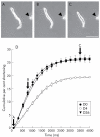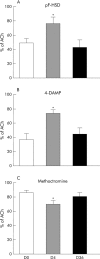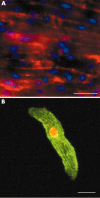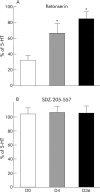Divergent changes to muscarinic and serotonergic signalling following colitis
- PMID: 16014744
- PMCID: PMC1774788
- DOI: 10.1136/gut.2005.066563
Divergent changes to muscarinic and serotonergic signalling following colitis
Abstract
Background: The altered motility of the inflamed intestine derives in part from changes to the contractility of the intestinal smooth muscle cell. While modifications to the muscarinic receptor system are identified, changes to 5-hydroxytryptamine (5-HT; serotonin) receptors that also mediate contraction are less well studied.
Methods: In the trinitrobenzene sulphonic acid model of rat colitis, we used receptor antagonists to identify changes in receptor utilisation that accompany the selective reversal of the impaired contractile response to acetylcholine (ACh) and 5-HT during colitis (day 4 (D4)) and following resolution of inflammation (day 36 (D36)).
Results: In isolated circular smooth muscle cells, challenged with ACh, the muscarinic 3 receptor (M3R) antagonists 4-DAMP and pF-HSD each showed a 50% decrease in antagonism on D4 while the M2R antagonist methoctramine more than doubled its potency, showing a decreased role of M3R and an increased role of M2R, respectively. These changes were fully reversed by D36. In contrast, the 5-HT2 receptor (5-HT2R) antagonist ketanserin was sharply decreased in effectiveness on D4, with a further decrease by D36, when the contribution of 5-HT(2A)R was only 22% of control. There were no changes in response to the 5-HT4R antagonist SDZ-205-557 at any time. Western blotting identified decreased expression of 5-HT(2A)R on D36 versus controls, further supporting the conclusion that the persistence of the impaired response to 5-HT was due to decreased expression of the excitatory 5-HT(2A)R.
Conclusions: Thus the lasting decrease in receptor expression and resulting impairment of the contractile response will compromise the capacity for an appropriate response to 5-HT, which may contribute to the intestinal dysfunction seen in post-enteritis syndromes.
Figures







References
-
- Moreels TG, De Man JG, Dick JM, et al. Effect of TNBS-induced morphological changes on pharmacological contractility of the rat ileum. Eur J Pharmacol 2001;423:211–22. - PubMed
-
- Cao W, Vrees MD, Kirber MT, et al. Hydrogen peroxide contributes to motor dysfunction in ulcerative colitis. Am J Physiol Gastrointest Liver Physiol 2004;286:G833–43. - PubMed
-
- Shi XZ, Sarna SK. G protein-mediated dysfunction of excitation-contraction coupling in ileal inflammation. Am J Physiol Gastrointest Liver Physiol 2004;286:G899–905. - PubMed
-
- Sarna SK. Physiology and pathophysiology of colonic motor activity (2). Dig Dis Sci 1991;36:998–1018. - PubMed
-
- Collins SM. The immunomodulation of enteric neuromuscular function: implications for motility and inflammatory disorders. Gastroenterology 1996;111:1683–99. - PubMed
Publication types
MeSH terms
Substances
LinkOut - more resources
Full Text Sources
